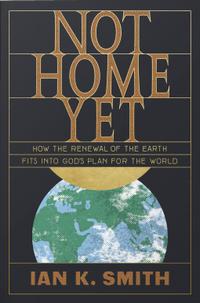 Not Home Yet: How the Renewal of the Earth Fits into God’s Plan for the World
Not Home Yet: How the Renewal of the Earth Fits into God’s Plan for the World
by Ian K. Smith
eARC, 176 pg.
Crossway, 2019
Read: August 4, 2019

In the beginning, we’re told, God created the heavens and the earth. As Rod Rosenbladt used to say (maybe still does, it’s been a while since I heard him), “God likes matter, He made it.” The Scriptures are replete with post-Fall references to God visiting Earth, coming to Earth and dwelling with His people. This is what the Incarnation and the bodily resurrection are about. Yes, the risen Christ ascends to Heaven—but He’s coming back to renew the planet. That’s what it’s all about. The goal of humanity is not going to Heaven after we die, but to live with Him in our resurrection bodies on a renewed Earth. That’s what this book is about, in a nutshell—how Creation isn’t to be abandoned, discarded and therefore it doesn’t matter what we do. Instead, we’re caretakers of this place waiting to be renewed when our pilgrimage is complete.
Smith begins his case with Genesis 1-2 and what this tells us about God’s attitude toward His creation. Then he moves on to the Fall and God’s work through his redeemed people to renew the Earth, through the Flood and the covenant made with Earth, to the eventual establishment of Israel and his dwelling with His people in the Tabernacle and Temple—all of which points to the ultimate tabernacling with humanity in the person of Jesus Christ. Then Smith moves into a discussion of Christ’s resurrection and what it means for His people and this world as explained by the Apostles—what it means for this world and how we should view the world.
Now, I shared the general, overall thesis of the book before I read this—but I hadn’t given it much thought, and didn’t see it in the kind of detail that Smith brought out. I found most of this book fascinating and relish the opportunity to give it a slower, more careful read in the future. I found the explanations and arguments carefully framed and well-reasoned. There’s a chapter or two that I highlighted the majority of, and every chapter has a good amount of highlighting, the way he put certain points was very helpful. I could’ve used a little more depth (not possible in a book of this length, and the goal was probably something involving length to draw in—or not scare off—readers).
There are some problems with the book if you ask me. I can’t buy, at all, his arguments about Genesis 6:1-4 (that “sons of God”=angels*), but as it’s not pivotal to his overall argument, it’s not a big deal for me (it just gave me a little pause).
* I know it’s not unique to Smith, but it’s rare enough that I run into it that it stuck out to me. And, no, I won’t waste anyone’s time debating that here, it’s not that type of book. Read Bavinck for one of the quickest arguments against it, or check out Christ the Center, Episode 373.
My major reservation about this book is the lack of application—I’d have preferred a chapter or two (or four?) of “given this, how then should we live?” Smith hints at, even points toward, what the believer should do in light of this thinking. But to me, it seemed as if he was reticent to show how these ideas should affect the way that readers should put these ideas into action, how they should impact what they do from day to day—or how to think about their actions and society (ecclesiastical, political, geographic—take your pick). Yes, a good deal is self-evident, but I’d appreciate having it spelled out (if for no other reason than it’d be good to put some meat on these bones).
The book is a bit brief, and (again) I’d like to see some of what he said expanded upon, but what’s there is really good, thought-provoking, faithful to the text of Scripture and consistent. It was a rewarding read, and I think it’ll be an even more rewarding re-read. It’s an accessible book and one that I’d encourage people to pick up and discuss.
Disclaimer: I received this eARC from Crossway via NetGalley in exchange for this post—I am grateful that both groups gave me the opportunity.
—–

![]()

